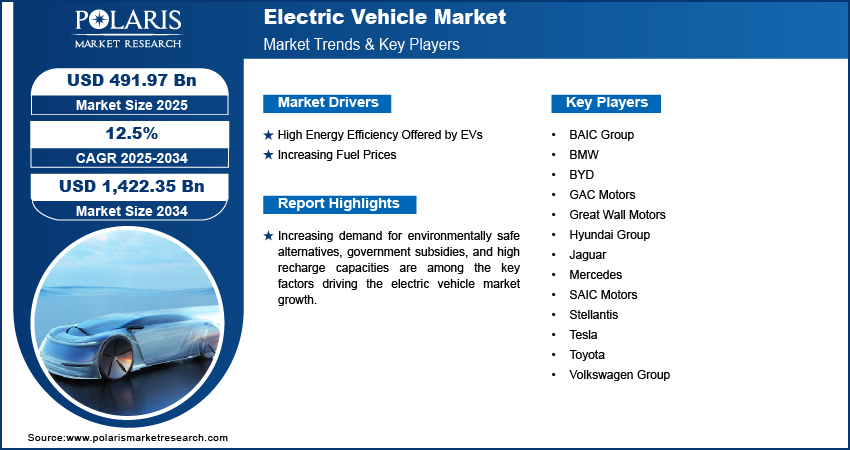The global electric vehicle (EV) market is on an unprecedented growth trajectory, projected to expand from USD 491.97 billion in 2025 to approximately USD 1,422.35 billion by 2034, registering a compound annual growth rate (CAGR) of 12.5% during the forecast period . This surge is fueled by technological innovations, supportive government policies, and a global shift towards sustainable transportation solutions.
Market Overview
Electric vehicles have transitioned from niche alternatives to mainstream mobility solutions. Factors such as advancements in battery technology, increasing environmental awareness, and stringent emission regulations have accelerated EV adoption worldwide. Governments across the globe are implementing incentives, subsidies, and infrastructure developments to promote electric mobility, further propelling market growth.
Market Segmentation
By Vehicle Type:
- Battery Electric Vehicles (BEVs): Fully electric vehicles powered solely by batteries, offering zero-emission transportation.
- Plug-in Hybrid Electric Vehicles (PHEVs): Vehicles combining internal combustion engines with electric propulsion, allowing for extended range and flexibility.
- Hybrid Electric Vehicles (HEVs): Vehicles utilizing both electric motors and internal combustion engines, optimizing fuel efficiency.
By Battery Type:
- Lithium-Ion Batteries: Dominant in the EV market due to high energy density, longer lifespan, and decreasing costs.
- Nickel-Metal Hydride Batteries: Known for reliability and safety, commonly used in HEVs.
- Lead-Acid Batteries: Cost-effective but with lower energy density, used in limited applications.
By Application:
- Passenger Vehicles: Leading the market share, driven by consumer demand for eco-friendly personal transportation.
- Commercial Vehicles: Growing adoption in logistics and public transportation sectors for cost savings and emission reductions.
- Two-Wheelers: Significant growth in urban areas, especially in Asia-Pacific, due to affordability and convenience.
Key Market Players:
- BAIC Group
- BMW
- BYD
- GAC Motors
- Great Wall Motors
- Hyundai Group
- Jaguar
- Mercedes
- SAIC Motors
- Stellantis
- Tesla
- Toyota
- Volkswagen Group
Polaris Market Research has segmented the electric vehicle market report on the basis of type, propulsion type, drive type, vehicle speed, power source, vehicle class, end use:
By Type Outlook (Revenue – USD Billion, 2020–2034)
- Scooters
- Motorcycles
- Three-Wheelers
- Passenger Cars
- Buses
- Trucks
By Propulsion Type Outlook (Revenue – USD Billion, 2020–2034)
- BEV
- PHEV
- FCEV
By Drive Type Outlook (Revenue – USD Billion, 2020–2034)
- FWD
- RWD
- AWD
By Vehicle Speed Outlook (Revenue – USD Billion, 2020–2034)
- Less Than 100 MPH (Max. Speed)
- 100MPH to 125MPH (Max. Speed)
- Above 125 MPH (Max. Speed)
By Power Source Outlook (Revenue – USD Billion, 2020–2034)
- Less than 100 kW
- 100 kW to 250 kW
- More than 250 kW
By Vehicle Class Outlook (Revenue – USD Billion, 2020–2034)
- Low Priced
- Mid-Price
- High Price
By End-Use Outlook (Revenue – USD Billion, 2020–2034)
- Personal
- Commercial
𝐄𝐱𝐩𝐥𝐨𝐫𝐞 𝐓𝐡𝐞 𝐂𝐨𝐦𝐩𝐥𝐞𝐭𝐞 𝐂𝐨𝐦𝐩𝐫𝐞𝐡𝐞𝐧𝐬𝐢𝐯𝐞 𝐑𝐞𝐩𝐨𝐫𝐭 𝐇𝐞𝐫𝐞 @ https://www.polarismarketresearch.com/industry-analysis/electric-vehicles-ev-market
Regional Analysis
Asia-Pacific:
Asia-Pacific dominates the global EV market, accounting for over 46.5% of the market share in 2024 . China leads the region with aggressive EV adoption, supported by government incentives and a robust manufacturing ecosystem. India is also witnessing rapid growth, with increasing investments in EV infrastructure and favorable policies.
Europe:
Europe is experiencing substantial growth, with countries like Norway, Germany, and the Netherlands at the forefront of EV adoption. Stringent emission regulations and incentives for EV buyers are key drivers. The region is also investing heavily in charging infrastructure to support the growing EV fleet.
North America:
North America holds a significant share of the EV market, with the U.S. leading in adoption. Tesla’s presence has been instrumental in popularizing EVs, prompting traditional automakers like Ford and General Motors to expand their electric offerings. Government initiatives and increasing consumer awareness are further boosting the market.
Conclusion
The global electric vehicle market is set for transformative growth over the next decade. Technological advancements, supportive policies, and changing consumer preferences are converging to accelerate the shift towards electric mobility. Stakeholders across the value chain must adapt to this dynamic landscape to capitalize on emerging opportunities and drive sustainable transportation forward.
More Trending Latest Reports By Polaris Market Research:
Carbon Credit Validation Verification and Certification Market
Digital Identity Solutions Market
Point-Of-Sale (Pos) Terminals Market

